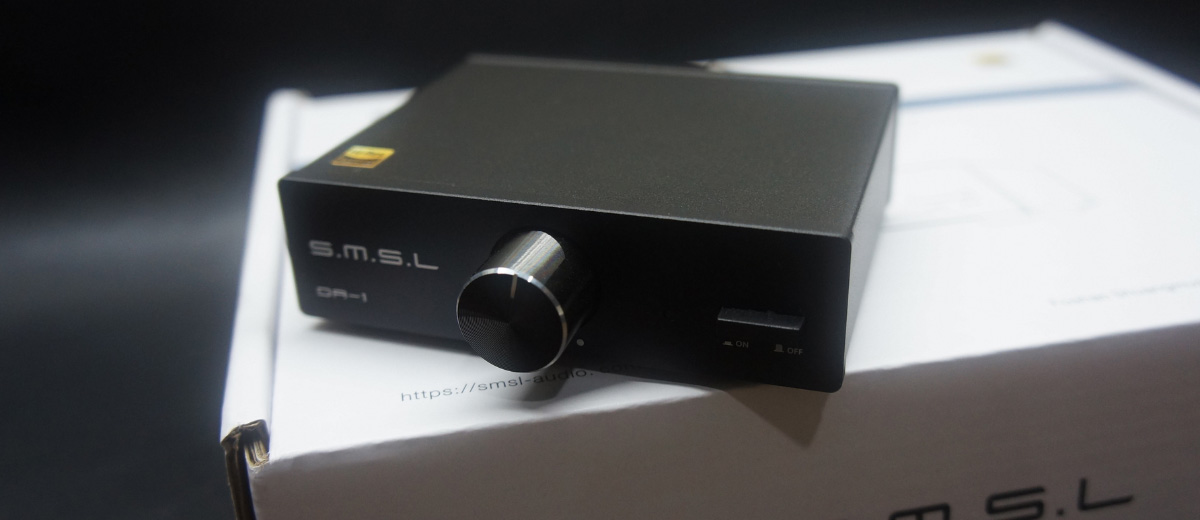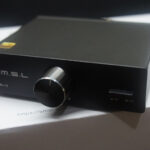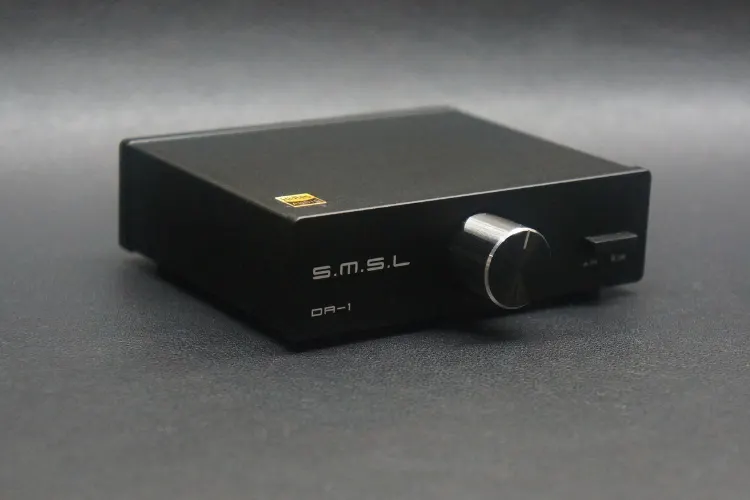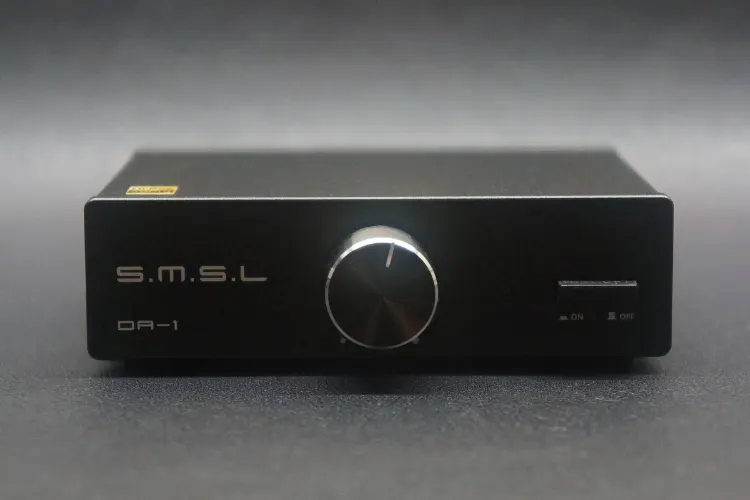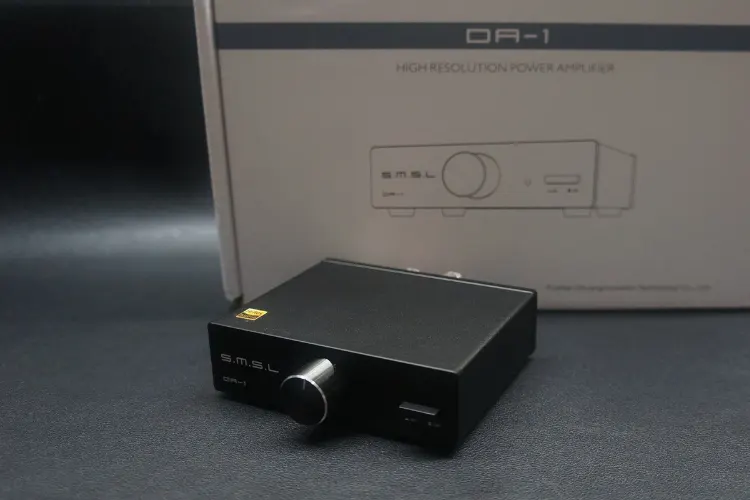In this feature, we review the SMSL DA-1, which is an ultra-compact desktop stereo power amplifier capable of up to 65Wx2 into a 4Ω speaker load. It is priced at $49.99.
Disclaimer: This sample was sent to us for our honest opinion. Headfonics is an independent website with no affiliate links or partnerships. We thank Shenzhen Audio and SMSL for their support.
Click here to learn more about SMSL products that we have previously featured on Headfonics.
Note, that this article follows our latest scoring guidelines which you can find in more detail here.
SMSL just loves the art of diminutive component design with “no-nonsense” pieces of audio equipment such as the popular SMSL SU-1 DAC which we reviewed last year.
Today’s subject is no exception with the equally small, dedicated desktop speaker amplifier, the DA-1.
Offering up to 65W x 2 (4Ω) output capability, this Class D speaker amplifier has a form factor much smaller than most headphone amplifiers, and at $49.99 it could well be a very useful gateway to first-time speaker enthusiasts on a tight budget.
Tech Highlights
At the heart of the DA-1 is the Texas Instrument TPA3118 chip. Texas Instrument has been on a roll recently, consistently releasing chips found in value-centric speaker amplifiers by the likes of Aiyima or Fosi Audio.
The chip and architecture of the DA-1 enable this little amplifier to drive up to 65W into 4Ω with 2 channels driven.
Despite an emphasis on the bare essentials, the DA-1 does pack a few clever tricks under its sleeve such as its use of a POP sound control circuit.
Those with existing speaker setups are well aware of the annoying and jarring noises that some amplifiers make upon startup. This circuitry implemented by SMSL aims to prevent this, not only protecting your hearing but also protecting your speaker driver from unwanted spikes as well.
A positive byproduct of the DA-1’s minuscule form factor is the short signal path within its circuitry. This design ensures that the analog signal passing through the unit is exposed to as little noise and interference as possible, aiming to deliver the purest most resolving audio signal into your speakers.
Design
The form factor and general design philosophy of the DA-1 are quite similar to the SMSL’s own SU-1, a sub-$100 DAC we took a look at recently. Similarly to the SU-1, the DA-1 makes use of what seems to be a CNC-machined aluminum shell with a black anodized finish.
The DA-1’s shell is machined with sleek chamfered edges, eliminating sharp edges that could get away while using or setting up the unit. This was quite impressive since even some of SMSL’s pricier devices such as the D-6s have sharp edges that aren’t as nicely chamfered.
The front of the unit has the SMSL logo as well as the DA-1 branding towards the left of the faceplate. The middle of the faceplate houses the black aluminum volume knob with a silver ring and position indicator.
Towards the right of the volume knob is the unit’s power button. The button itself is wide and protrudes beyond the profile of the faceplate. Right next to the power button is a bright LED that shines red when in standby mode, and shines green when turned on.
Coming in at 96×30.5×102mm, the DA-1s compact build lets it remain discreet in dedicated 2-channel listening set-ups, but even in cramped desktop or laptop computer workstations.
I appreciated this since book-shelf speakers on their own already tend to take up a lot of desk space, making each square inch saved by the amplifier seem like free real estate.
Despite weighing in at a measly 230g, heavy RCA cables do not pull the unit too much, thanks to the four rubber feet that elevate the DA-1.
I/O
The DA-1 has a straightforward and minimalist I/O layout. On the back panel, we can see the unit’s sole input, a single pair of RCA inputs for connecting different sources such as DACs, streamers, phono pre-amps, etc.
Right next to the RCA jacks are the unit’s sole output, two pairs of speaker terminals for connecting left and right speakers. The speaker terminals are gold-plated and accept banana plugs or bare wires.
The DA-1 also comes with a 19V/3.42A power adapter that plugs into the barrel plug next to the speaker terminals.
The input and output options of the DA-1 are quite literally as bare-bones as they could be. However, at a sub-$50 price point, this unit most likely targets the specific use case of novice speaker users making use of just one input and just one pair of speakers.
Controls
The DA-1 has an equally barebones, yet intuitive control scheme. It comes with no other controls besides the power button and the volume knob.
Pressing the power button cycles it between “On” and “Standby”. When on standby, the power button protrudes outwards, as shown by the instructions printed onto the faceplate. Pressing the button turns on the unit and changes the LED indicator from Red to Green.
As one would expect, turning the volume knob clockwise increases the volume, and turning it counterclockwise lowers the volume level. The unit makes use of an analog volume knob with stops at the 4 o’clock and 6 o’clock positions. The knob itself has more resistance than I anticipated, but it is by no means bothersome.
There is no remote control, input selector, tone controls, or display. However, at this price point, these omissions are warranted.
Packaging & Accessories
The DA-1 comes in a plain white cardboard box with the SMSL logo and model name on the front. Inside the box, you will find the DA-1 amplifier, the power adapter, a user manual, and a warranty card. Both the unit and its power supply are packed neatly in dense foam with good tolerance.
There are no other accessories included, such as RCA cables or speaker wires. Those will need to be purchased separately if not available on hand. But once again, I find the lack of inclusions quite reasonable given the price range.
Sound Impressions
Summary
The DA-1 is a neutral and clean amplifier that does not color or alter the sound of your speakers. It delivers a clean and detailed sound, with a wide soundstage and good dynamics with an engaging presentation.
The DA-1 has enough power and control to easily drive most bookshelf speakers, and it can handle various genres and styles of music without any issues.
Timbre
Low-end bass drum hits are not given any additional weight and bass riffs do not bleed into the lower mids. Sub-bass hits are reproduced in a satisfying tight manner and never seep their way into the rest of the frequency response.
The mid-range tonality is flat and neutral as well, leaning ever so slightly to the warm side. String instruments are well articulated and textured, and vocal performances are presented in a way that maintains all nuance.
Vocals and brass instruments are presented with sparkle and a good sense of detail. The treble region is presented in a very detailed manner. Different cymbal strikes can be easily differentiated from one another, but it does not introduce any sibilance in its presentation.
Staging and Dynamics
The DA-1 has an impressive dynamic range, contributing to the exciting and dynamic sound signature of the unit. The first thing that stood out was how “uncompressed” complex mixes came off when compared to my daily driver Aiyima T9.
The sheer volume difference between the loudest and softest instruments within a mix gives the music a more natural yet engaging tonality. This also aided in me being able to dissect songs more easily, letting me appreciate individual performances much more.
The DA-1’s staging performance is quite good, giving tracks a more atmospheric sound, especially in lower-end rumbles and bass riffs.
It has accurate imaging and positioning that place the instruments and vocal locations precisely in the space. There is no sense of vagueness and individual instruments can be easily isolated.
Power
Connected to my Wharfedale Diamond 3, a vintage pair of compact bookshelf speakers with a nominal impedance of 8 ohms and sensitivity of 86 dB, the DA-1’s 65W power output was able to deliver a reasonable listening volume with ease.
When connected to my D-6S DAC at its maximum output setting, I only needed to turn the DA-1’s volume knob to the 8 o’clock position for nearfield listening. For far-field listening, I only needed to turn it’s volume knob to slightly above the 9 o’clock position.
With this level of power output, I would have preferred more granular volume control. While testing for noise, I noticed a slight hiss when the volume knob is placed anywhere between the 10 o’clock and 3 o’clock positions.
Regardless of the reason, the hiss exhibiting in a volume range that wide was quite disappointing given the class-leading performance the DA-1 exhibited thus far.
Click on page 2 below for sound impressions and our selected comparisons.

